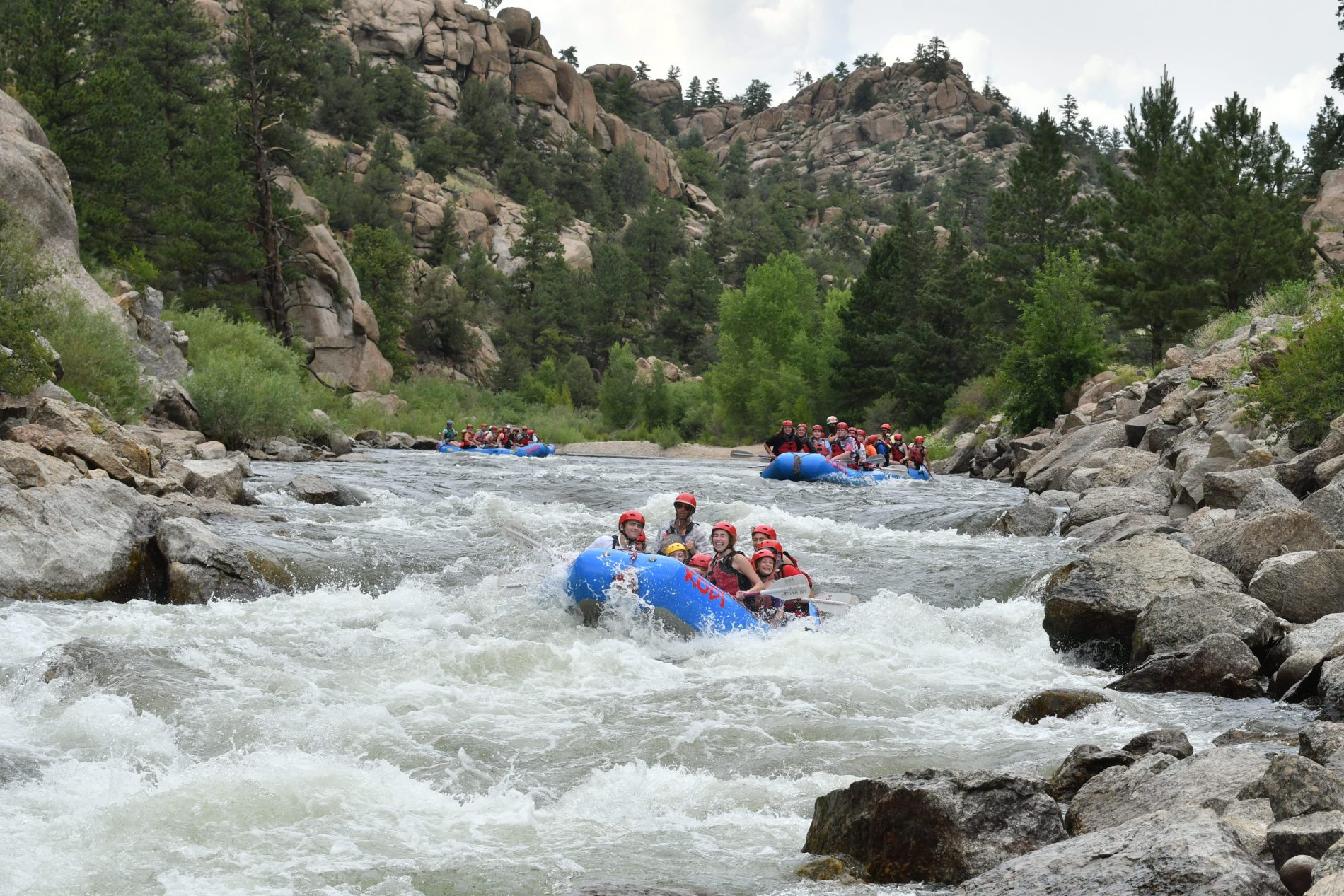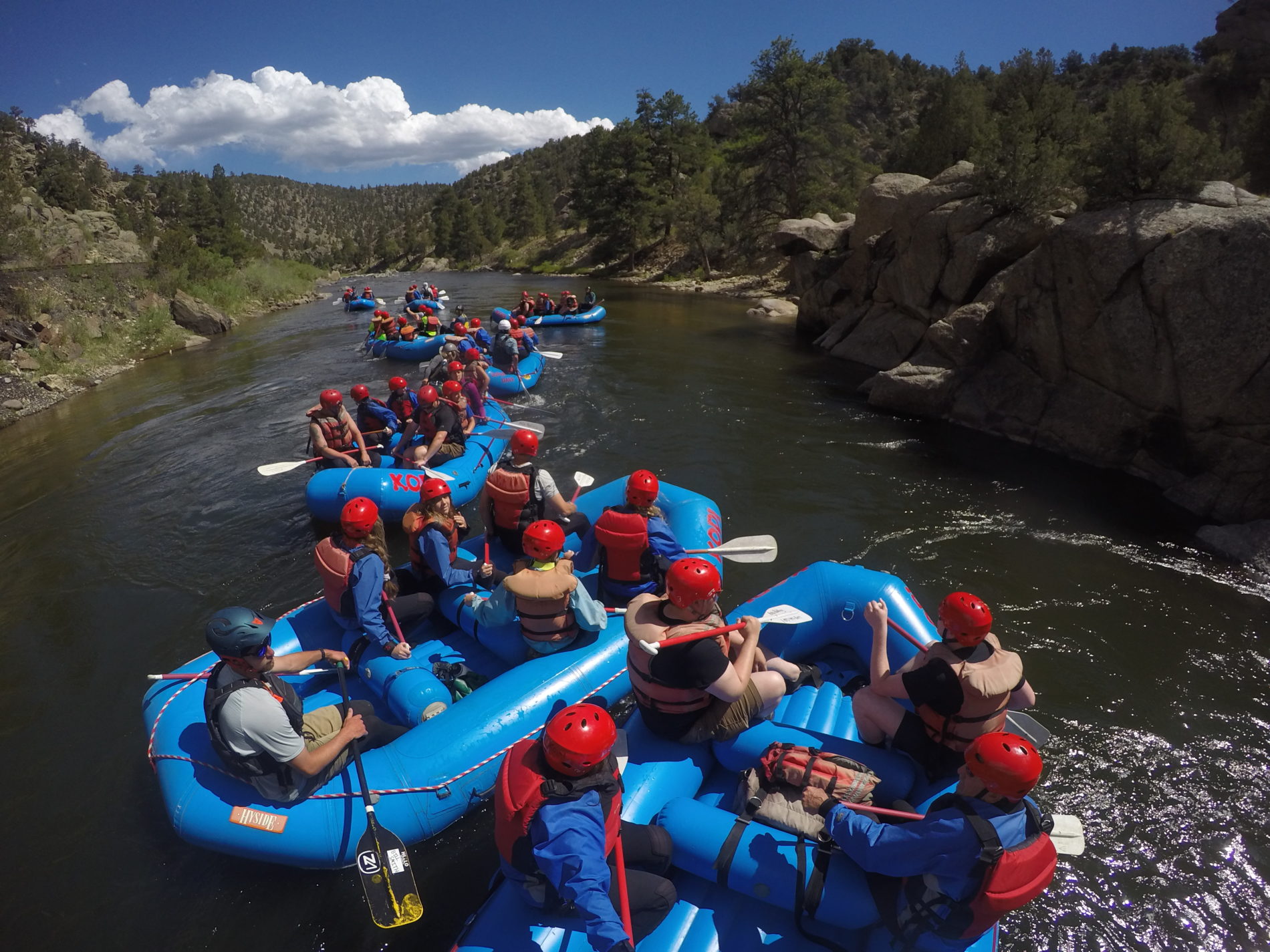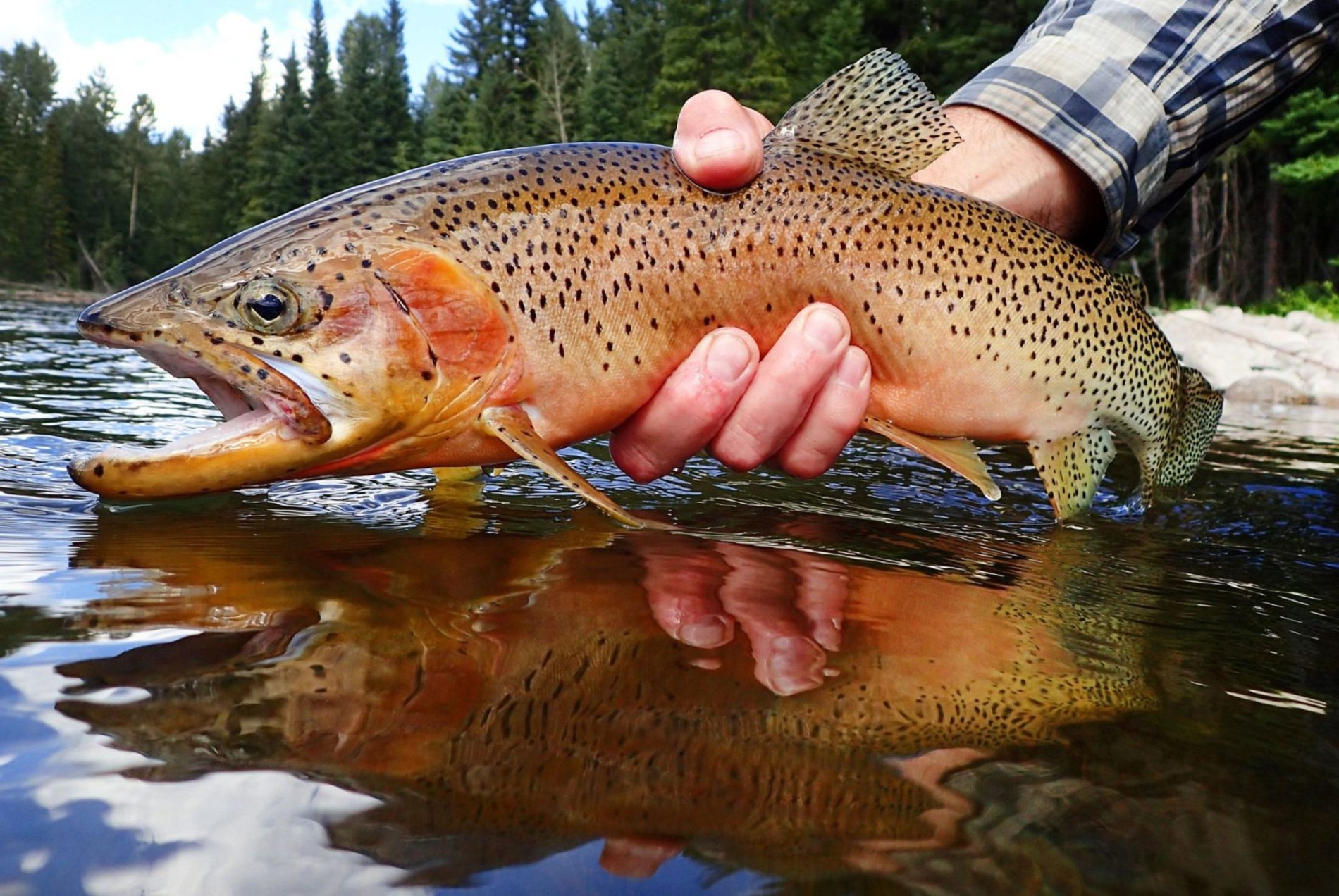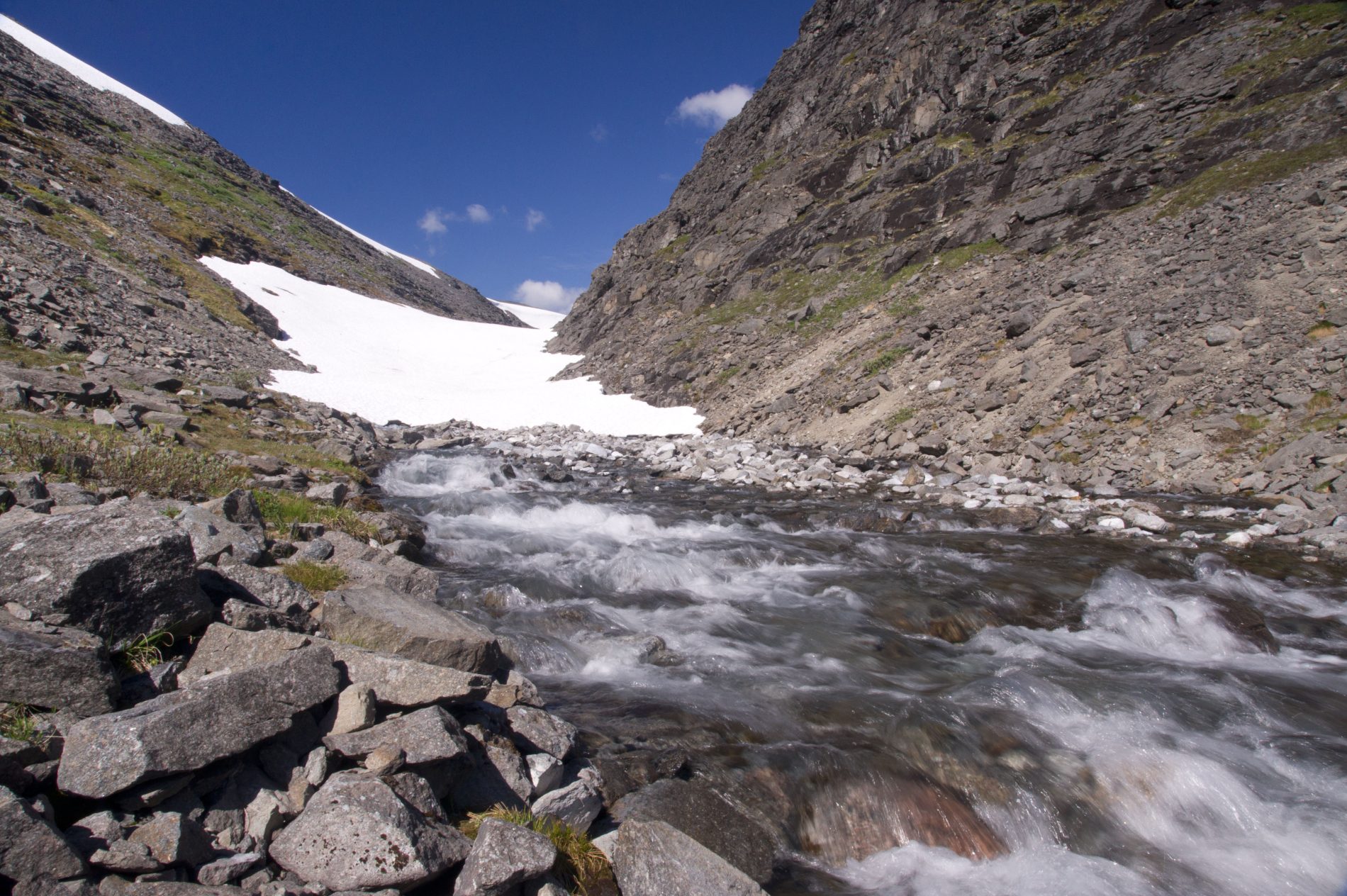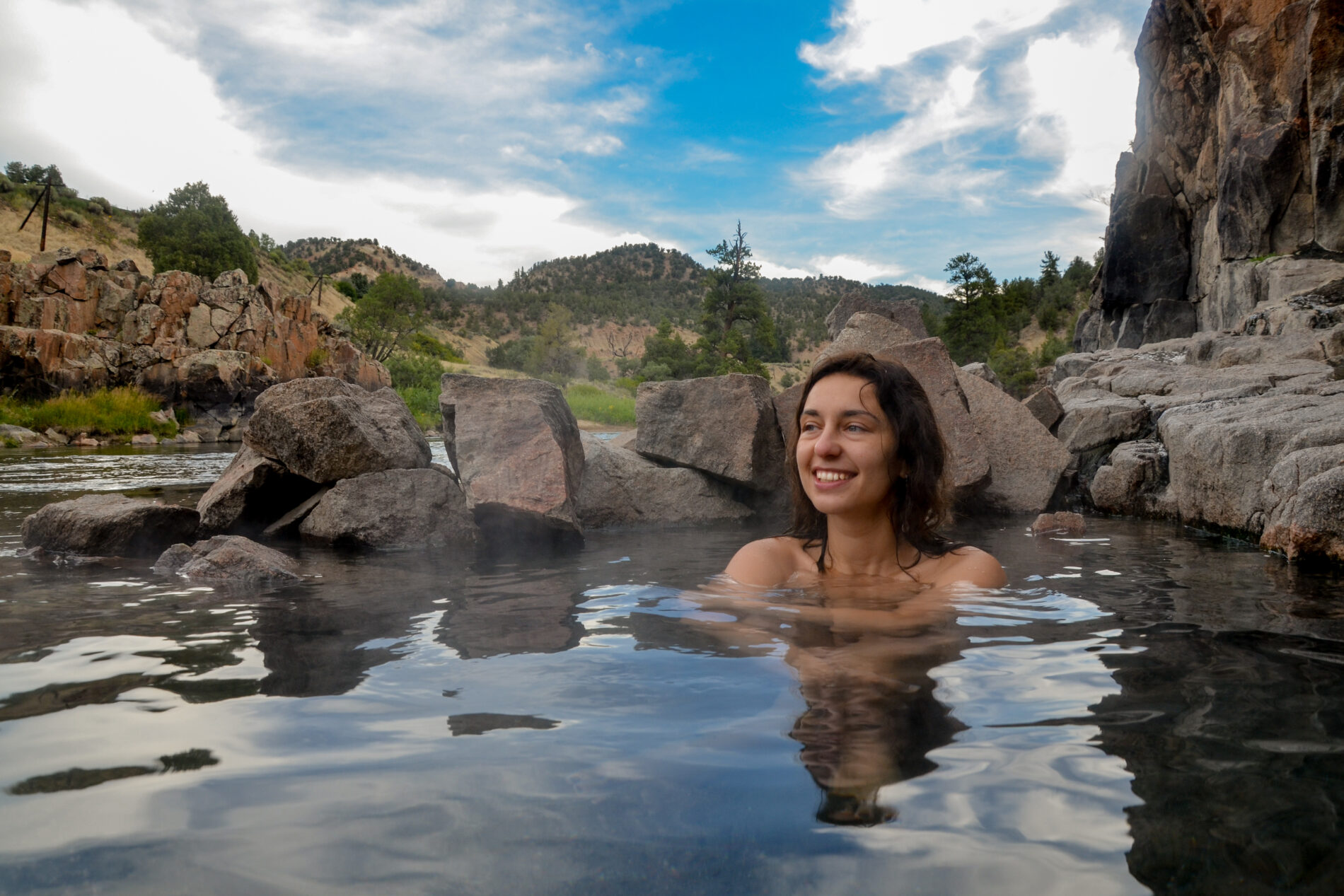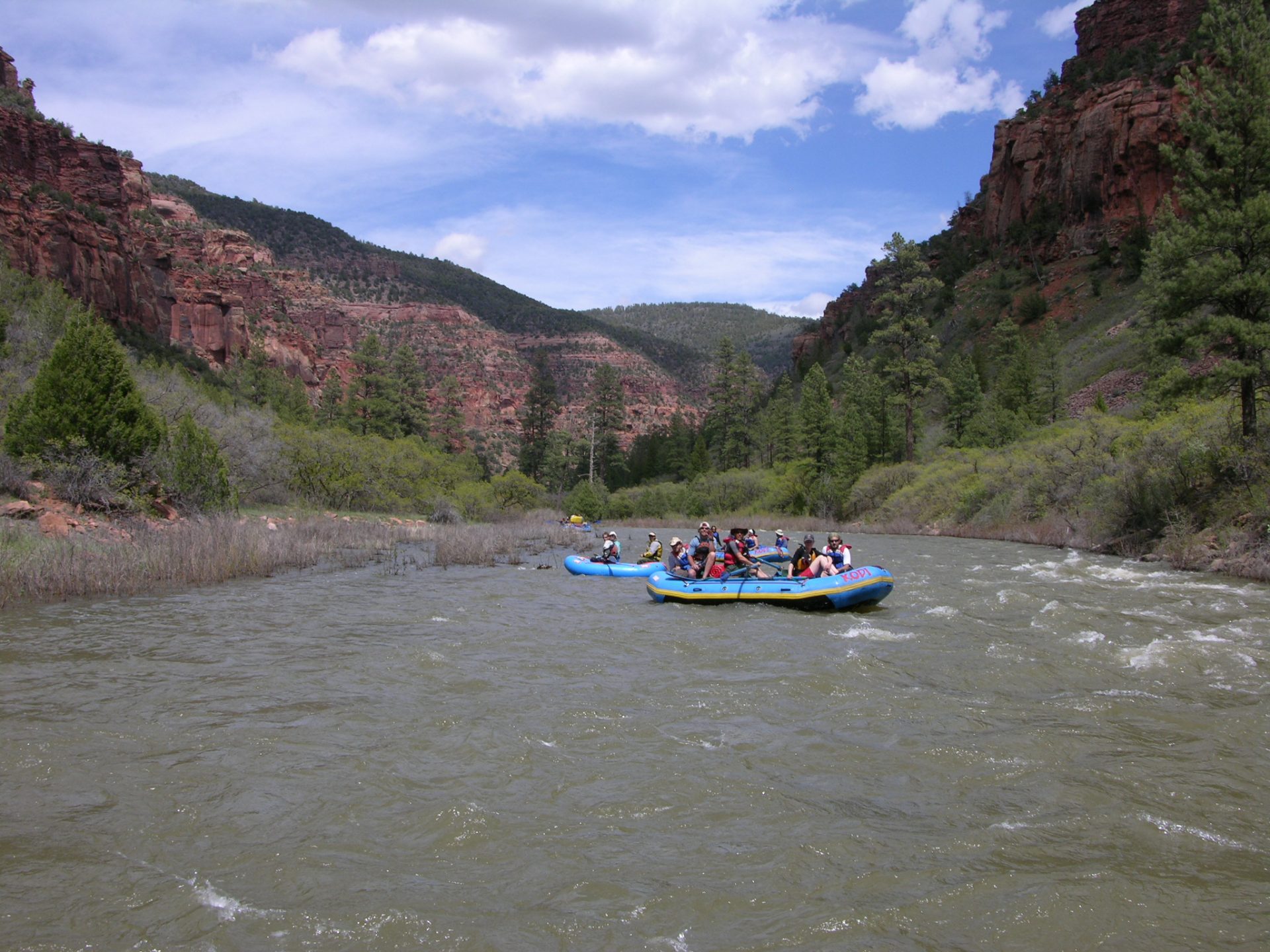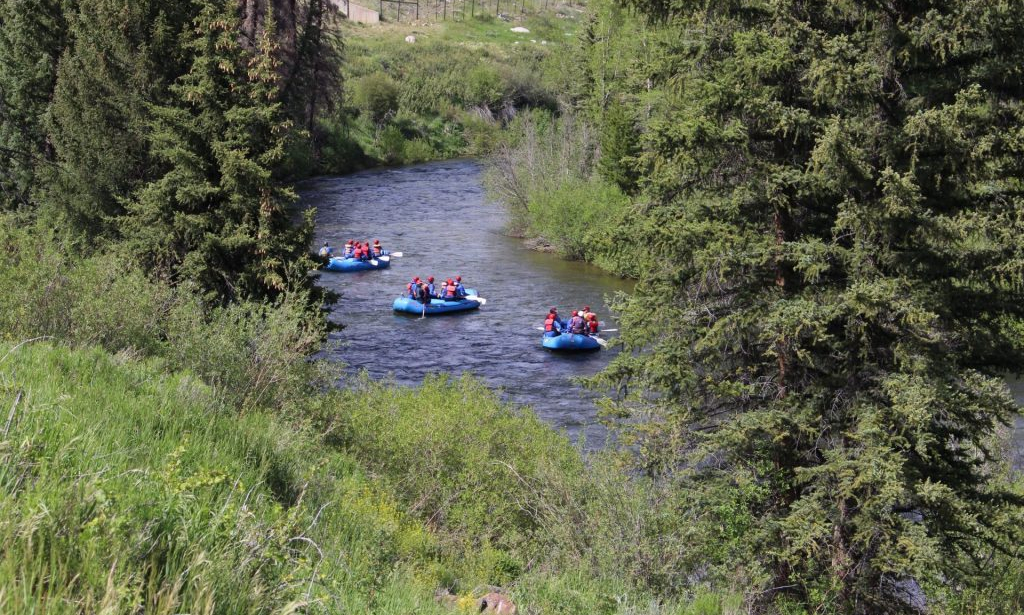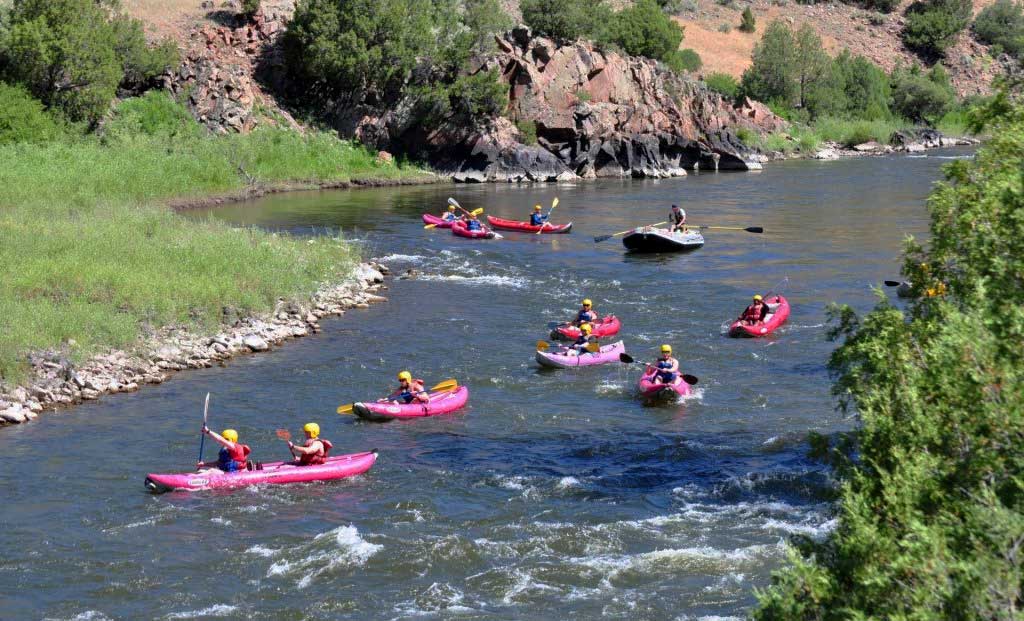Best Whitewater Rafting in Colorado: Top Places to Raft
Whitewater rafting in Colorado delivers adrenaline-pumping adventure set against jaw-dropping scenery. From thundering Class IV rapids to gentle floats perfect for families, the state’s rivers offer something for every thrill-seeker. Whether planning your first rafting trip or chasing your next big challenge, choosing the best destination for you—and the right outfitter—makes all the difference.
Discover Colorado's top whitewater rafting destinations, from the Arkansas River to the Dolores River. Plan your outing today with Kodi Rafting!
Why Choose Colorado for Whitewater Rafting
Colorado’s rivers run wild with adventure for thrill-seekers of every level. The state’s high-altitude snowmelt fuels an incredible range of rafting experiences—from peaceful floats to heart-pounding rapids. Each river offers a different challenge, shaped by terrain, elevation, and flow.
With over 300 days of sunshine a year and river seasons that stretch from spring to early fall, it’s no wonder Colorado tops the list for whitewater lovers. Whether you're paddling past granite cliffs or through alpine forests, the scenery adds to the rush.
Rafting with a professional outfitter like Kodi Rafting adds another layer of confidence. Our guides bring years of on-the-river expertise, extensive training, and a passion for the outdoors, ensuring you're safe and thoroughly enjoying the thrill of the expedition.
Top Whitewater Rafting Destinations in Colorado
Colorado’s rivers deliver world-class whitewater experiences, with options for every skill level—from families seeking gentle floats to thrill-seekers chasing Class IV excitement. At Kodi Rafting, we guide excursions on some of the best stretches in the state. Here's where you’ll find the most memorable whitewater rafting in Colorado:
Arkansas River
The Arkansas River is Colorado’s most popular rafting destination for good reason. With stunning canyons, splashy rapids, and multiple sections to choose from, it offers something for everyone.
- Browns Canyon: This section combines fun rapids with incredible views and is perfect for families and first-timers.
- Numbers & Pine Creek: Fast, technical, and thrilling—ideal for expert paddlers.
- Bighorn Sheep Canyon: A scenic, approachable stretch with moderate whitewater and wildlife sightings.
Kodi Rafting offers guided tours on all major sections of the Arkansas River, tailoring each expedition to your comfort and adventure level.
Clear Creek
Just 45 minutes from Denver, Clear Creek is one of the best whitewater rivers in the state. Its narrow canyons and boulder-strewn rapids make it a favorite for action-packed half-day trips.
- Rapids range from beginner to advanced
- Frequent splashes and technical lines
- Surrounded by rugged, alpine scenery
Our Clear Creek guides know the river’s every twist and turn, offering an exhilarating and safe ride.
Dolores River
The Dolores River offers a remote and scenic rafting experience through secluded canyons, archaeological sites, and pristine wilderness. Flowing through southwestern Colorado, it's a rare and seasonal adventure ideal for those seeking solitude and natural beauty.
- Features Class II–IV rapids, depending on water levels
- Dramatic sandstone cliffs, ancient ruins, and wildlife sightings
- Best suited for experienced rafters and wilderness enthusiasts
Safety is always the top priority with Kodi Rafting—adventure flows naturally from there.
What Sets Kodi Rafting Apart
We combine thrills with professionalism at Kodi Rafting to deliver unforgettable whitewater experiences. Our seasoned guides know these rivers like the backs of their paddles, and our top-tier equipment ensures every trip is as safe as it is exhilarating.
What makes us stand out?
- Guides who are trained, knowledgeable, and passionate about the outdoors
- Well-maintained rafts and safety gear for every adventure level
- A focus on customer satisfaction—from first-time rafters to seasoned paddlers
- Personalized excursions for families, groups, and thrill-seekers alike
Kodi Rafting runs tours on several other scenic waterways across the state, from Kremmling to Buena Vista. So wherever the current takes you, we’ve got the perfect trip to match.
Plan Your Next Excursion with Kodi Rafting
From the legendary rapids of the Arkansas River to the scenic beauty of the Dolores, Colorado offers some of the best whitewater rafting in the country. Kodi Rafting combines local expertise, well-trained guides, and a passion for adventure to create unforgettable river expeditions. We run tours across Colorado, from heart-pounding to family-friendly.
Visit our website to explore the many rafting options we offer statewide, and contact us to plan your whitewater rafting adventure today!
Raft Beginner's Guide: How to Get Started with Whitewater Rafting
Whitewater rafting is the perfect activity if you want to try something new and exciting. The thrill of riding down a river in the company of friends or family and a professional guide will make your trip memorable and fun!
Is whitewater rafting scary? As long as you follow your guide’s instructions, you can look forward to a safe, and fun adventure. From making travel arrangements to packing the proper gear, KODI is here to assist you. In this raft beginner's guide, we’ll discuss everything you need to know to get comfortable.
Getting Started: The Class System
The International Scale of River Difficulty is a helpful tool for identifying the difficulties in rivers worldwide. It does not always work perfectly because some parts of a river can be different from others, and water levels and flow rates change daily with seasons and climate. That said, let's look at how hard whitewater rafting is depending on the rapids.
Class I - Calm, deep currents ensure safety as long as one stays clear of rocks and other debris.
Class II - With straightforward rapids, this is considered the novice class, where everything is easy to navigate as long as you know what you're doing.
Class III - This class is intermediate because it takes skill and experience to successfully maneuver through complex river sections while dealing with currents faster than lower classes.
Class IV - This class requires precise paddling skills since one encounters unavoidable rapid waves, holes, and constrictions. Remember that this class is always intense and powerful.
Class V - Requires high expertise and extreme endurance and not runnable by commercial rafters.
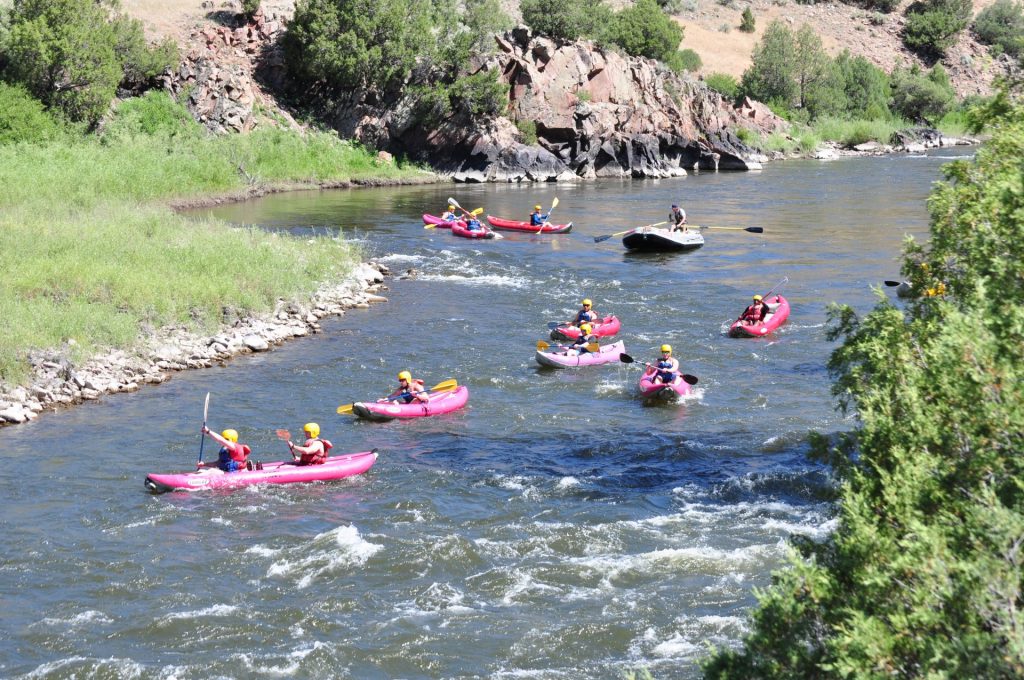
Whitewater Rafting Tips
Here are some whitewater rafting tips you should know before hitting the river:
- Study the river you'll be rafting on. Rocky mountain rivers can be unpredictable, so it's important to know what you're getting into.
- Always heed your rafting guide and follow their instructions. They're there for a reason.
- Enjoy yourself! The point of whitewater rafting is to have fun, so keep your inexperience from getting in your way. You can make even your first time a memorable experience.
Whitewater Rafting Clothing Tips
One of the most important tips for whitewater rafting is to dress appropriately. The KODI team will equip you with a Personal Flotation Device (PFD), a helmet, a wetsuit, neoprene booties, and/or a splash jacket depending on the weather conditions that day. And don’t forget your sunscreen, sunglasses (with safety leash!), and a hat that fits under the safety helmet to protect you from the sun!
Whitewater Rafting Safety Tips
Whether you are a first-timer or an experienced rafter, whitewater rafting can be an exciting and thrilling experience. However, it's important to follow whitewater rafting safety tips. At KODI Rafting, we make sure that our guests are accompanied by a licensed and certified rafting guide with proper training, while dressed and equipped appropriately for the day.
Key Terms to Know
For those whitewater rafting for the first time, here are a few fun terms to learn:
- Put in: This is the starting point of your rafting trip where the raft enters the river
- Take out: Ending point of a river rafting adventure where the raft gets loaded on a trailer and you leave the river
- River left/river right: These are directions a rafting guide gives while you're rafting. Always note that these are the directions you will use while maneuvering down stream while looking downstream
- Eddy: an area of the river with current different from the main river current, frequently on the edge of the river after an obstruction (like a boulder) and with a light whirling motion, which is a great place to “pull over” in the raft to wait for other boats to catch up, or “eddy out”
- Boil: Where the water surface looks like boiling water, usually caused when water is being forced into one loacation, often appearing at the bottom of rapids where fast moving water is flowing into slower moving water that is pooled
- Swimmer: Individual who fell out of the raft during a rafting trip
- Flip: Used when a raft has completely overturned
- Safety kayak(er): Individuals accompanying rafts in kayaks who support swimmers or groups, usually following a group of rafts
- Portage: Term used to describe a team carrying a raft around a river obstacle on the shore to avoid a specific section of the river
- Broach: Used to indicate that a boat has its broadside facing downstream
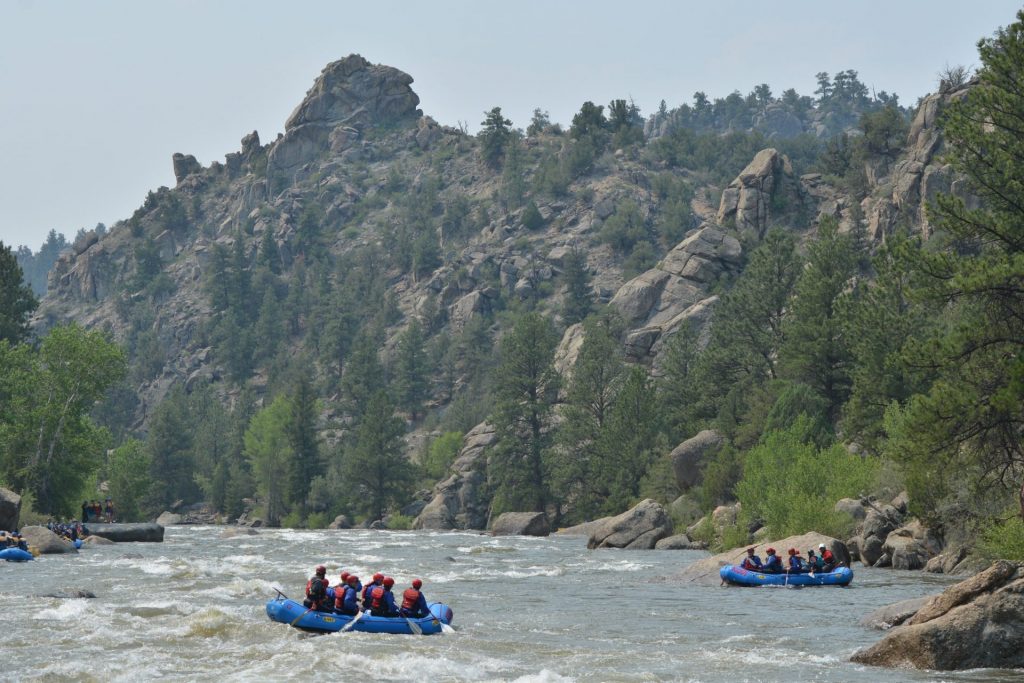
More Safety Tips
So, is whitewater rafting hard? The perceived difficulty level depends on the river conditions, your physical strength, and your comfort level. If you're a beginner, starting with a calmer river is likely best since you can work your way up as your skill level progresses. That said, here are some specific first-time whitewater rafting tips:
- Always hold the raft paddle properly - the paddle is the most common source of injury
- Ensure your PFD (personal flotation device) and helmet fit properly and are tightened down so they don’t slip or come off
- Stay in the boat at all times when you’re on the water unless the group is specifically going to shore and your guide recommends getting out on shore
- Learn various the various self-rescue techniques your guide recommends in the pre-trip safety talk so you’re able to get to safety in the unlikely event you fall overboard
- Know the commands and key terms to communicate effectively from your guide
- Stay aware of your surroundings at all times
- Never try to stand up in a river - your feet can get caught between rocks and injur your ankle or leg
- Always listen to your raft guide
- Don’t panic, you’re in safe hands!
Let's Go Rafting!
Now that you know the basics of whitewater rafting, you're ready to hit the river! And our staff and guides will be there for you every step of the way. All of our specialists complete a special whitewater rafting training course at KODI Rafting here in Colorado with skills assessments and instruction both on and off the river. They're there to help ensure you have a safe and fun experience on the water.
Always remember: when in doubt, ask your Colorado rafting guide.
Whitewater River Rafting or Animal Watching?
Stop and take a deep breath… Feel the wind and experience the sights of Colorado’s wild animals from the seat of a whitewater raft.
Whether you’re hiking trails or paddling the rapids of the Arkansas, Clear Creek, Blue, or Colorado rivers with Kodi, you’re guaranteed to see some wildlife! Colorado’s diversity of landscapes and vegetation is home to a wide variety of wildlife like the bighorn sheep, elks, golden eagles, and varieties of trout.
We want to provide a quick reminder to never feed or disturb any wildlife. For more information on the leave no trace ethos, check out our recent blog.
Fish in Colorado’s Rivers – Rafting
When you’re whitewater rafting the Numbers, Browns Canyon, or Pine Creek you may be lucky enough to see some fish. The main fish population in the Arkansas, Clear Creek, Blue, and Colorado rivers are brown and rainbow trout, but you’ll occasionally see some Brook Trout too. Another animal you’ll commonly spot in the rivers are Beavers! Beavers aren’t fish obviously, but there is a possibility you will see them and their amazingly clever dams.
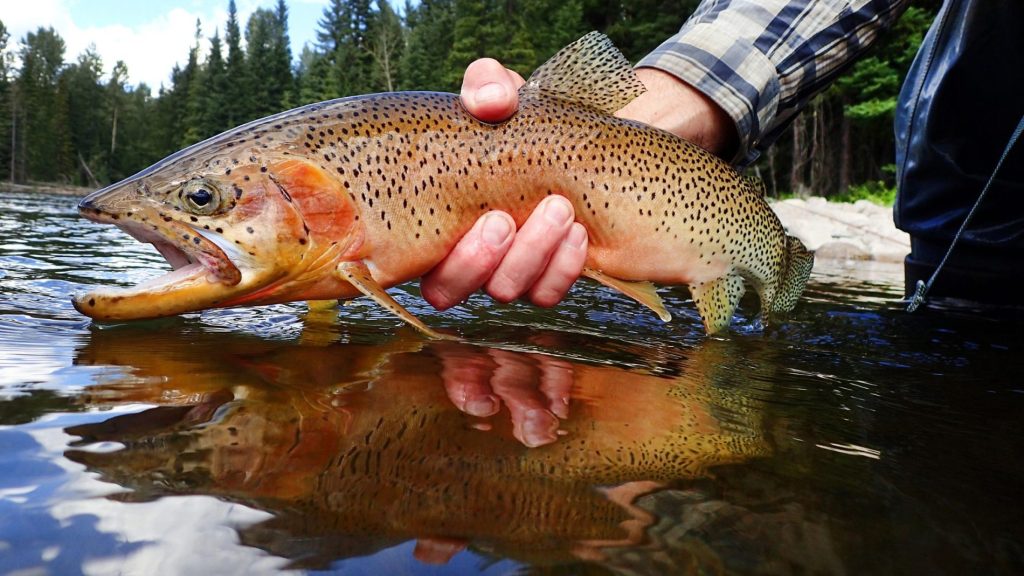
Did you know the Colorado native trout before the 1850s was the greenback cutthroat trout? The Arkansas river used to be teeming with greenback cutthroat trout, but sadly the mining runoff in Leadville killed this fish species in the valley of Buena Vista. You may be asking yourself, HOW? Greenback cutthroat trout died due to a heavy amount of metal contamination and soil erosion. However, Leadville National Fish Hatchery is working to resolve that since the greenback cutthroat trout are endangered, and it’s their main priority to repopulate the surrounding rivers and lakes.
A long-spoken legend between the senior whitewater river rafting guides is that Northern pike fish have been caught in the Arkansas River. Northern pike are high alpine lake fish that like deep and cold water, but sometimes they’re flushed out of the lakes and have been found in our rivers! There are no guarantees of seeing a pike, but the senior river guides swear by this tale.
Unfortunately, we don’t allow fishing from the rafts because of the other guests on your boat, but if you are looking to fish be sure to check out the requirements for your fishing license in Colorado and some rules and regulations you can reference to legally fish in Colorado.
Colorado’s Birds as Seen Overhead From the River
When rafting, it’s easy to forget to look up, but we highly encourage it! Here in Colorado, you will see great blue herons, bald and golden eagles, turkey vultures, and Corvus. Common birds you may spy are sparrows, robins, and swallows. The swallows are very prevalent when it is raining/drizzling. Did you know that birds predict the weather? When it’s raining, swallows fly low because they have very sensitive ears. When the barometric pressure drops, swallows will fly as close to the ground as possible because the air density is greatest the lower they go.
Another common bird you or guide will often spot are in the Corvus family, which includes ravens, crows, and magpies. You won’t miss these birds, as they are very noisy!
Some striking birds you have a possibility of seeing are the red-winged blackbird, blue jay, North American goldfinch, and steller’s jay. The steller’s jay looks like a metallic blue bird, and is super unusual and truly beautiful. Check out the photo below of a steller’s jay in the wild.
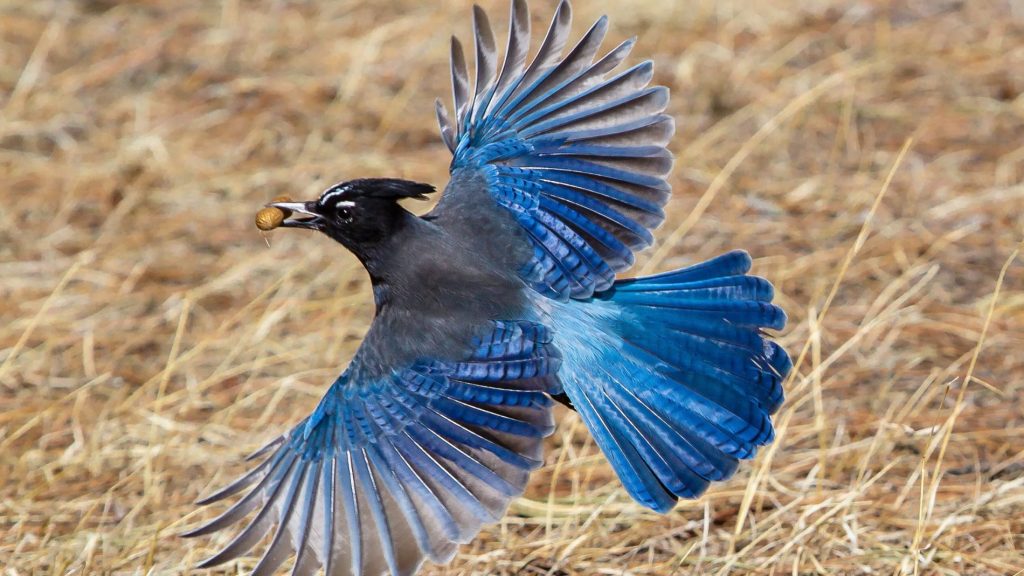
Some rare birds that are less likely to cross your path but you may be lucky enough to see are the western tanager, great blue herons, bald eagles, and golden eagles.
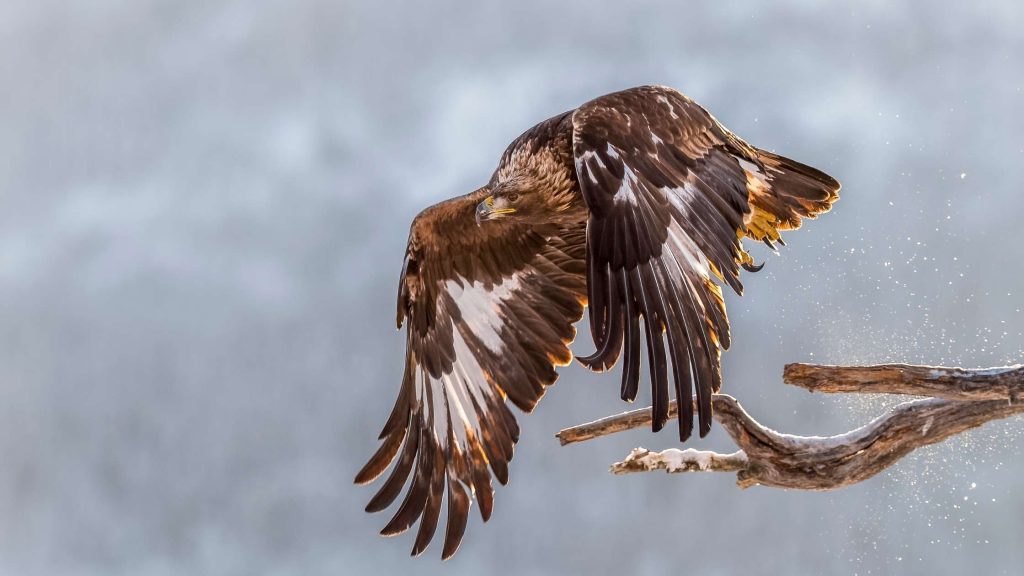
Birds we can almost guarantee you will see are peregrine falcons, turkey vultures, and good old Canada geese, as well as the occasional duck or two!
If you would like some more pictures of birds and wildlife animals in Colorado, be sure to check out FDRD, Friends of the Dillon Ranger District which also offers more information about our forests.
Colorado’s Land Animals in The White River National Forest
Colorado is the land of the wild for larger wild animals as well. Yes, there is a possibility you’ll come across black bear, elk, mountain lions, coyotes, red foxes, moose, bobcat, mule deer, white tail deer, porcupine, pikas, snowshoe hare, Rocky Mountain bighorn sheep, and mountain goats. Did you know that snowshoe hare’s beautiful coat changes colors with the season? In the wintertime, snowshoe hares are white to disappear into the snow and in the summer they turn a nice shade of brown to blend in with the forest floor and bushes. When whitewater river rating, our groups can get very loud and animals hate loud noises, so it’s less likely you’ll see any of the larger animals, but we definitely get a glimpse on occasion.
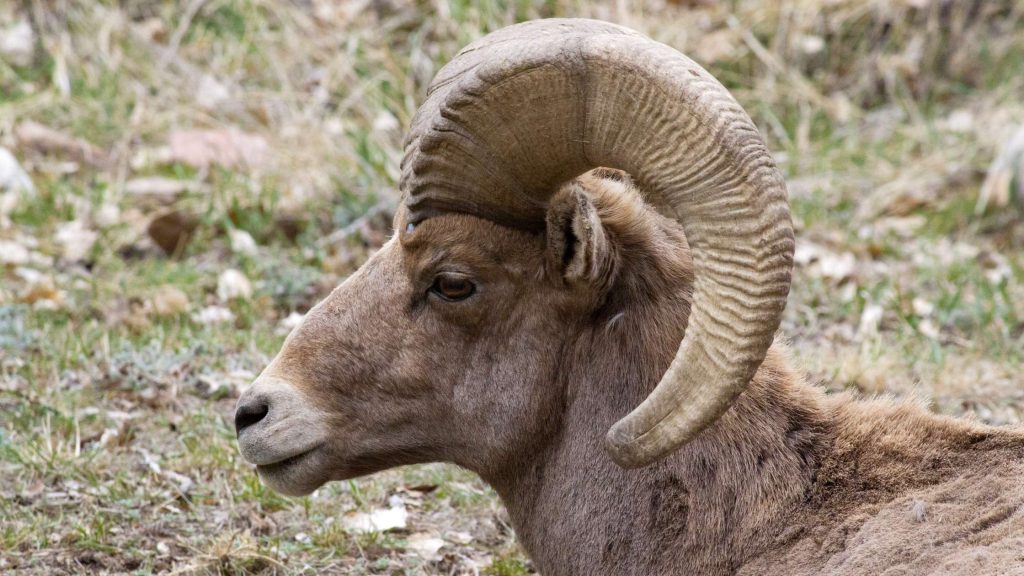
There are many Colorado marmots that you may see or just hear. The largest of the Colorado land squirrels is the yellow-bellied marmot. The yellow-bellied marmot hibernates throughout the winter, and when approached you will hear a loud warning whistle, which is very unique and earns these animals the nickname “whistle pigs.”
Recently, gray wolves were reintroduced into the Colorado mammal landscape. We have never seen any wolves on our rafting trips to date, but there have certainly been sightings of them throughout the plains and in the ranching communities. In the gray wolf reintroduction process through natural migration, one pack has already established itself in the North Park Mountain Valley near Walden, Colorado, but we have not seen any near the Upper Colorado River, the Arkansas River, or the Blue Rivers.
Ready to animal watch from a whitewater raft? Call and get signed up for your next Colorado adventure in Buena Vista, Breckenridge, Frisco, Idaho Springs, Kremmling, or Cortez Colorado through Kodi Rafting. If you have any questions about what raft trip will be best for you and your friends or family feel free to give us a call at 877-747-RAFT. We are always happy to answer all your questions and recommend the ideal trip for you!!
Colorado Winter Snow’s Impact on Spring Rafting
We’re in the heart of winter, but we can’t help but wonder how the upcoming rafting season will kick off this spring! After all, winter snowfall and snowpack in the winter have a direct correlation to how our rafting season plays out. Even in the winter months, we start to have a pretty decent idea of how rafting will be later in the year.

How does snowpack in the winter impact our rafting season?
Snowpack forms from a series of snow storms throughout the season. Snowfall essentially builds layers of preserved moisture to form in high altitudes and cold weather areas. In the winter, snow pack greatly impacts skiing, snowboarding, snowmobiling, backcountry touring, and avalanche conditions, but it’s important to remember that snow pack affects Colorado year round - not just in the winter. During the warmer days of summer, snow pack can affect all your outdoor activities, especially whitewater rafting.
To put it simply, Colorado’s snowpack acts like a drip irrigation system. As temperatures rise in the spring, snow melts slowly and steadily, first saturating the dry ground, then flowing into our rivers and streams, and filling up our reservoirs. When we get heavy winter snowfall, that snowpack is likely to produce higher-than-normal water runoff in the rivers and streams across Colorado.
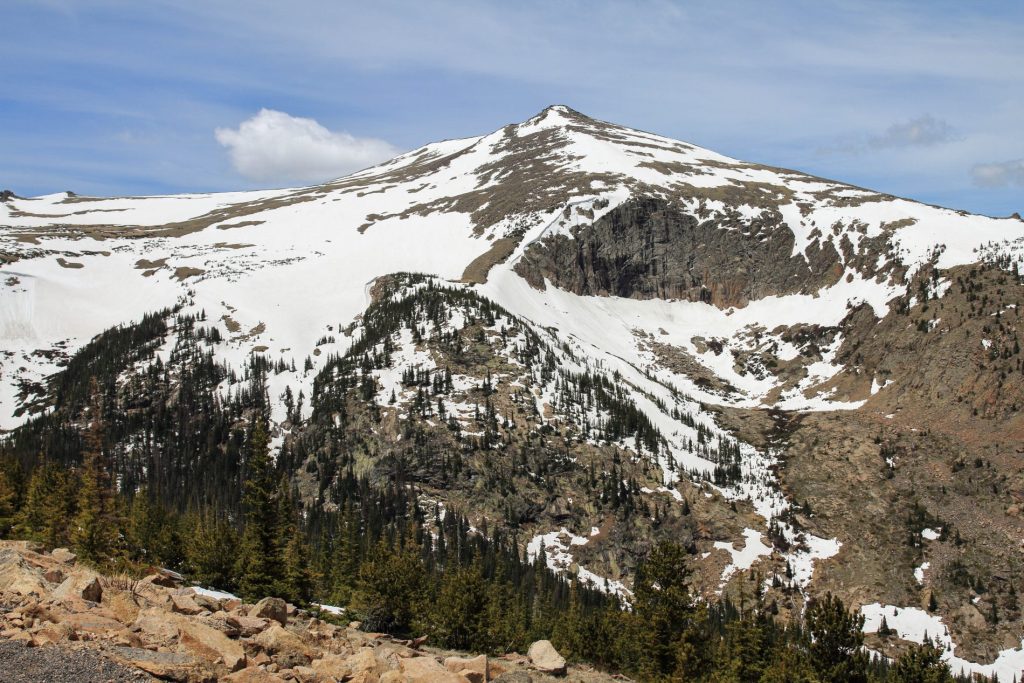
On the flip side, when Colorado experiences a winter drought without significant snowfall, rivers and stream levels drop and our rafting season may be shorter. Lower water means that our guests and raft guides will experience slower water along with lower water levels. For those of you excited about rafting in the Spring when water is likely to be higher, we encourage you to watch the timing if you want the most exciting whitewater of the season!
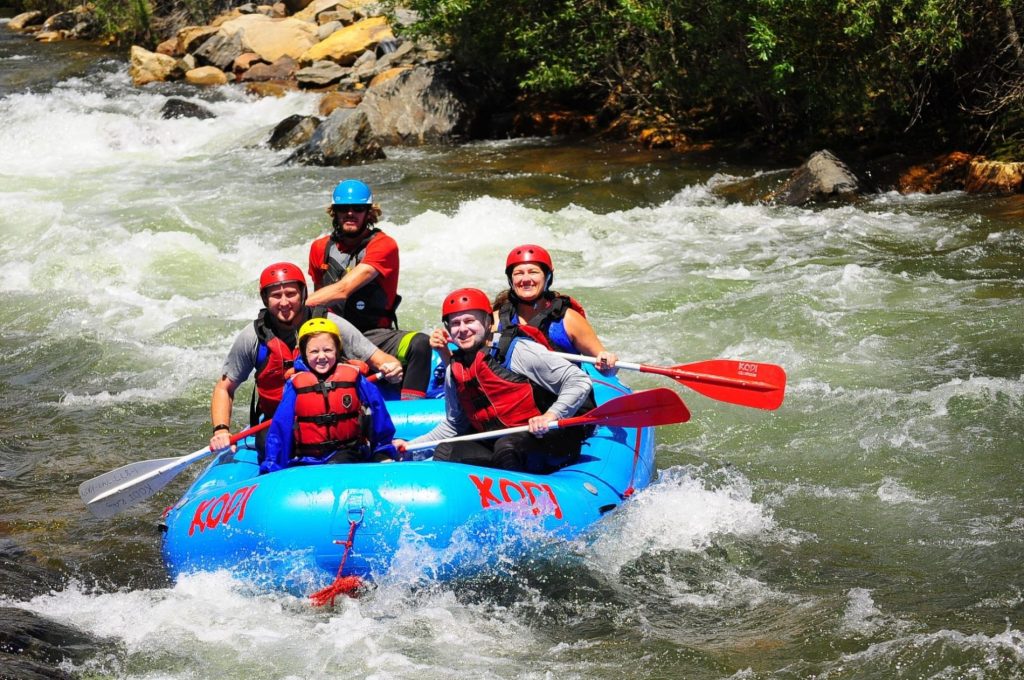
What are previous years showing us?
There is an impact we’re experiencing from our warming climate and ongoing drought. Climate change and warming temperatures can lead to faster snow melting. The trend of warmer climates over the years is concerning and is disrupting this system in numerous ways. Year after year, unusually dry soils from warmer temperatures and a lack of moisture has the earth absorbing more of the water from our snowpack. This means that less water is making it into rivers and streams, essentially limiting the efficiency of the melting snow. When temperatures rise earlier in the Spring and snow stops falling, the snow melts more quickly, and the land becomes drier in the late summer timeframe, impacting wildfire risk.
When researchers analyzed years of snowpack data across the western half of North America, especially in Colorado, they found that snow has been melting earlier in the year than it did in the mid- to late-20th century. If snowmelt begins to dry up earlier in the season, there is less runoff to flow through the ground during the summer months. Unless precipitation increases through rain in warmer weather, there will be fewer overall water resources for us all.
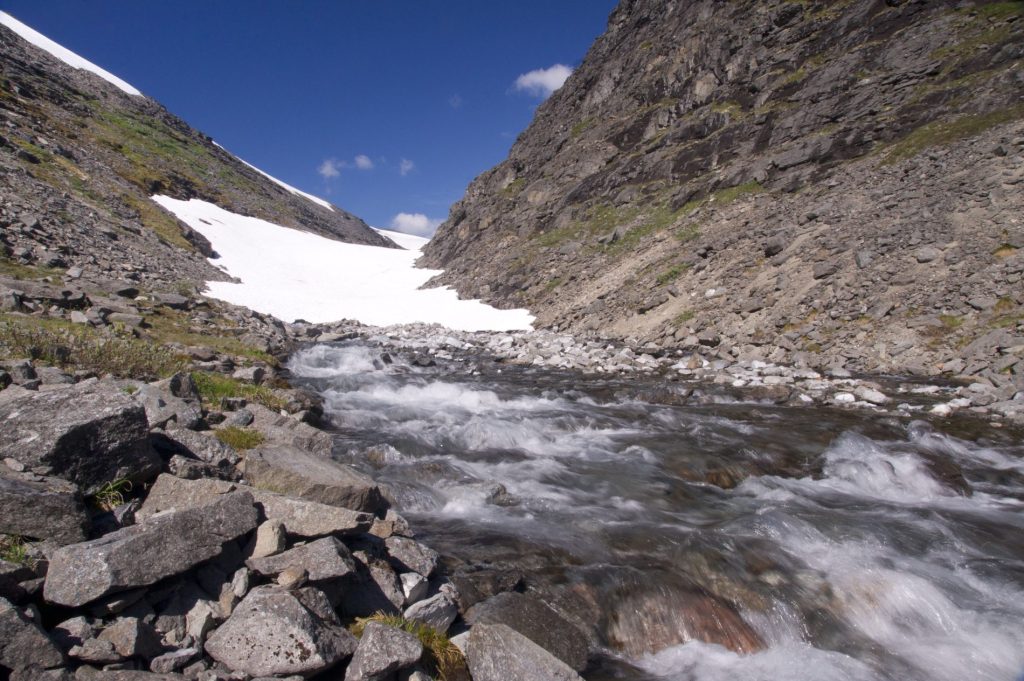
Colorado experiences many different seasonal changes throughout the year and we can even see weather change dramatically over the course of a single day. Our hope is always for more snow throughout our winters which in turn produces better rafting conditions for our whitewater raft guides and guests. High water is measured through stream gauge river sensors recording streamflow in cfs, which stands for cubic feet per second. In other words, river cfs is the amount of water flowing past the sensor at any given point in time. The more water rushing past the sensors indicates the whitewater volume moves at a very swift and fun pace.
Whether we have a long season of high water or lower river flows, we can’t wait to see you on the rivers this season. It’s not too early to start planning your trip with Kodi Rafting. Choose your river trip here and contact us today for information and reservations online or give us a call at 970-668-1548, so we can help guide your plan for experiencing the rivers of Colorado!
Kremmling, Colorado: A Haven for Outdoor Adventure in the Rockies
Nestled where the Blue River and Colorado River intersect, Kremmling is a haven for outdoor adventure and small-town charm in the Colorado Rockies. Whether you are looking for an exciting day maneuvering the rapids of the Upper Colorado on a Kodi whitewater raft trip, a scenic hike, or a tasty bite to eat at a local spot, you’re sure to find something that will bring you back to this Rocky Mountain town time and time again.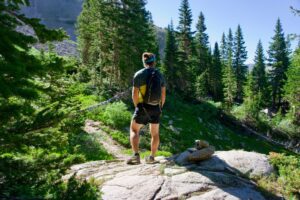
Get Out On the Hiking Trail
Lace-up your boots for a hiking expedition! For an easy-going out and back trail, try Windy Ridge which will lead you to a lake and is also friendly for four-legged friends. For more of a challenge, take a hike along the 2.8-mile Gore Canyon trail. Along the way, you can enjoy the scenery of the breathtaking canyon and even bring along camping gear for a night spent on BLM land for a small fee. Looking for a longer trip? Try the Silver Creek Trail in Arapaho National Forest. The main highlight of this 12-mile trail are wildflowers that can be spotted along the journey. No matter the difficulty level, a hike in the Rockies is always a great way to spend the day.
Enjoy the Views on a Scenic Drive
The Trough Road, which is part of the Colorado River Headwaters Scenic & Historic Byway, sits right outside of Kremmling offering breathtaking views. Driving along the route, you will encounter winding turns and stunning scenery including both the Colorado and Blue Rivers. Make sure to stop and take in the view from Inspiration Point for views of the Gore Canyon where you might even spot a raft floating by!
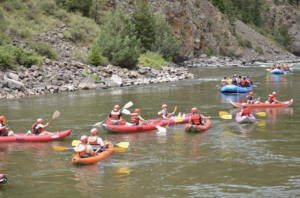
Spend Your Day on the Water
With two major rivers and a nearby reservoir within easy access, Kremmling is a hotspot for water recreation! Rent a boat or launch your own onto Wolford Reservoir where you can fish, water ski, knee-board, stand-up paddleboard, or simply enjoy being on the water. Looking for more adventure? Take a whitewater rafting trip along the Upper Colorado. Choose either a half or full-day raft trip that offers gorgeous scenery and mild waters perfect for families. Want to try navigating the river on your own? Book a duckie trip or add one to your rafting expedition to paddle on your own while still having the support of a nearby guide. Keep an eye out for local flora and fauna along the way and you may even catch sight of evidence of prehistoric creatures that once called the area home!
Take a Soak in the 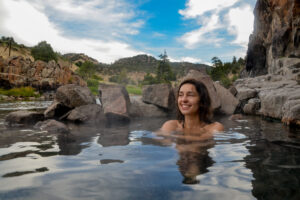 Hot Springs
Hot Springs
After a day of rafting on the river or a nice long hike, ease sore muscles with a soak in the Hot Sulphur Springs. Take your pick of 21 mineral pools, all heated to temperatures ranging from 95º to 112ºF from nature’s power from underground hot springs. Looking for even more relaxation? Book a massage to truly treat yourself to a day of relaxation.
For more of an adventurous day, you can hike a mile down to the Radium Hot Springs pools found along the Colorado River just a short drive outside of Kremmling. This experience offers scenic views while you sit in the natural pools. You can often find entertainment and friends along the way in the passing raft trips and cliff jumpers who dive into the chillier waters of the river. Whether you find a hot spring at the end of a hike or in a resort setting, a hot spring soak is the perfect way to replenish tired muscles and lift spirits after a great mountain adventure.
Grab a Bite to Eat at a Local Hotspot
A day of hiking, rafting, fishing, or relaxing in a hot spring will surely work up your appetite. After a day of adventure, be sure to head into town to grab a bite to eat at a local dining hot spot! Stop into the Grand Old West for homestyle cooking like chicken fried steak and mashed potatoes and gravy while you sit in a charming rustic setting. Other nearby eateries include Los Amigos Mexican Restaurant, the Moose Cafe, and Big Shooter Coffee which is the perfect place to grab a coffee, pastry, and even an ice cream cone!
Whether you are seeking a whitewater raft trip, a scenic hiking trail, or a calm getaway to enjoy hot springs, the Kremmling area offers something for everyone! Escape the hustle and bustle of city life and explore the charm of small-town life in the mountains by finding a quiet hiking trail, fishing in a reservoir, or grabbing a bit from a local restaurant. No matter how you decide to spend your time in this Rocky Mountain gem, you are sure to make memories you will never forget!
Classifications of Rapids for Whitewater Rafting in Colorado
Our whitewater rafting guests often ask us questions about river water depth, the kind of rapids they’ll be rafting through, and what the whole class system means as they prepare for their first or even 50th rafting adventure with us. So we thought we’d bring some clarity to the question and give you an overview of rapids classifications for whitewater river rafting … and provide some expertise on the topic.
Factors in Rapids Classifications
Rapids and the classifications of whitewater vary due to different circumstances: water levels can be high or low depending on the amount of snowmelt and vary as weather conditions change. Our beautiful snowcapped Rocky Mountain peaks melt and flow into Colorado streams, rivers, and reservoirs starting in earnest in May, which is the start of the spring runoff. The start of rafting season usually kicks off in the middle of May as the weather warms up, and tends to max out the highest water flow throughout Colorado depending on altitude and distance from the deepest snow pack. In general, spring snowmelt brings higher water and higher levels of difficulty while running our rivers primarily because the water runs fast and furious, forcing quick decisions as river features change. Water levels fluctuate dramatically throughout the summer and our guides can even see differing conditions between a morning run and an afternoon trip when water levels are in a high state of flux.
What are Rapids Classifications?
Rapids themselves are graded on a class system starting at 1 and progressing to 6. The higher up the scale they go, the more difficult and the more consequential the stretch of water will be. As an example, there are many variables that can change, either upgrading or downgrading the classification of a rapid. Rapid variables include water levels, objects, under
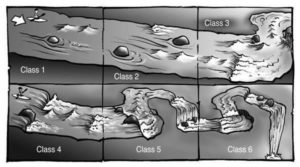
cut rocks, and strainers (like a log jam). Certain features within a river naturally are more difficult and make it more challenging to navigate. For example, Brown’s Canyon is less difficult to navigate than the Numbers section of the Arkansas River. This is why it’s so great to have an experienced raft guide to help you experience Colorado’s most beautiful areas safely. This, as well as having a great day of fun on the water, is what you experience when rafting with Kodi Rafting. Let’s explore the difference between each classification of whitewater in even more detail than is outlined on our website’s rapids classification page.
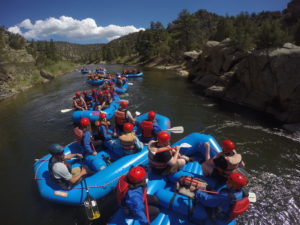
Class I is flat, easy moving current. Minimal moves, minimal difficulty. The most difficulty you experience on this level of river is navigating around bends and avoiding shallows, perhaps pulling into eddies. Think of this as a leisurely float down a river. Class I is about staying with the current and literally going with the flow.
Class II is moving current with slightly more difficulty and has specific moves that your raft guide needs to make in order to navigate the river efficiently. The difference between class I and II is the necessity to maneuver around objects or shallow sections. Class II is a moderate river trip and great for families. A bit more adventure and splashing without high anxiety. Join Kodi for class II trips on the Upper Colorado, Blue River, or Clear Creek for 1/2 day or full day trips.
Class III is a moderately difficult section of river, with slightly higher consequences, and with more difficult moves to be made by your raft guide. There is typically faster moving current than class I and class II, and there can be objects and things to avoid along your path. Some of these potential objects could impede your raft, or even flip you over if not navigated 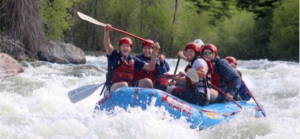 around properly. Class II, & III trips are your typical family trips with somewhat older or more adventurous family members. If you’d like to experience a higher level of family excitement, book our Arkansas 1/2 day or full day trip with Kodi at our Buena Vista location, or the Clear Creek Canyon trip departing from Idaho Springs to enjoy class III rapids.
around properly. Class II, & III trips are your typical family trips with somewhat older or more adventurous family members. If you’d like to experience a higher level of family excitement, book our Arkansas 1/2 day or full day trip with Kodi at our Buena Vista location, or the Clear Creek Canyon trip departing from Idaho Springs to enjoy class III rapids.
Class IV is a difficult stretch of river. A class IV section has fun, fast and technical rapids. Standing waves, big rocks, turbulent water, and difficult features are all things you will find on Class IV river runs. These rapids are active: multiple objects, multiple variables and multiple moves involved in order to navigate safely. The Numbers of the Arkansas River, and Clear Creek are examples of exciting options Kodi offers to raft this kind of trip, for a high level of 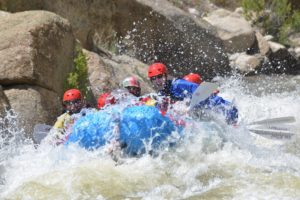 excitement and challenge.
excitement and challenge.
Class V is for experts only. This is the most challenging level for a commercially rafted trip. Class V includes lots of maneuvering, with fast consequential moves. Teamwork, communication, coordination, and strong paddling are needed to safely navigate Class V sections of whitewater. These rapids can have large drops, violent currents, and extremely steep gradients – and loads of excitement!
Class VI is extraordinarily difficult or non-runnable sections of river. Rafters face extreme imminent danger. Think cliff drops, big rocks, and scary aspects of challenge. Class VI level rapids are never run commercially, and are often walked around by rafters to avoid them.
So whatever level of challenge, splashes, and excitement you desire, Kodi Rafting can deliver. From calm float trips to expert runs to go big, give us a call to book the rafting adventure that suits your family, group, or yourself!
Call to book your whitewater adventure with us today at 877-747-RAFT or book online here. See you on the river!
KODI’s Rivers: An Overview
Arkansas River
The Arkansas River starts as a patch of melting snow in Leadville, Colorado, a city rich in mining history and famous for its 10,200-foot elevation. The Ark (as locals like to call it) gains momentum as it flows past some of the biggest mountains in Colorado, benefiting from their abundant snow melt in the spring and summer. From its headwaters, the Arkansas River deliver more than 100 miles of whitewater, making it the most popular river for rafting in the American West. The river’s appeal lies in its wide variety of trips and easy accessibility.
Blue River
The Blue River is roughly 65 miles long and is a tributary of the mighty Colorado River. Flowing from the Dillon Reservoir Dam just above the town of Silverthorne to the confluence with the Colorado River at Kremmling, the Blue River is easily a candidate for Colorado's most scenic river. Lined by cottonwood trees and crowned by the rugged Gore Mountains, the Blue River winds a scenic course through ranch land, and its public access points are popular among anglers and kayakers alike.
Clear Creek
Clear Creek is a tributary of the South Platte River that flows through Clear Creek Canyon in the Rocky Mountains directly west of Denver. It descends through a long gorge to emerge on the Colorado Eastern Plains where it joins the South Platte. Clear Creek is unusual in that it is a stream named "creek" fed by a stream named "river."
The Upper Colorado River
The Upper Colorado River Basin, defined by the river network above northern Arizona, is comprised of four states—Colorado, New Mexico, Utah, and Wyoming. These states contribute to the vast majority of the water coming into the Colorado River Basin, primarily through winter snowpack.
Colorado, specifically, is known as the Headwater State because it’s home to the headwaters of four major rivers: Platte, Arkansas, Rio Grande, and Colorado. The Colorado River flows west out of the slopes of Rocky Mountain National Park and connects to several tributaries, including the Animas, Eagle, Dolores, Yampa, Blue, and Roaring Fork Rivers.
Ten Mile Creek
Ten Mile Creek is a stream in Summit County. It rises above Copper Mountain Ski Resort and follows next to Interstate 70 for several miles before emptying into Dillon Reservoir. The creek and the paved trail that follows alongside it are easily visible from Interstate 70 between Frisco and Copper Mountain Ski Area.
Dolores River
A long and winding river in southwestern Colorado, the Dolores flows through canyons packed with enormous ponderosa pine and high sandstone cliffs in brilliant oranges and reds. The river continues its journey from the alpine scenery into the high desert and through canyons dotted with amazing white water, ancient ruins, and untamed wilderness.
Colorado’s Upper Colorado River
The Colorado River provides water to nearly 40 million people, flows through nine National Parks, and drives a $1.4 trillion economy. If the Colorado River basin were a country, it would be the world’s 7th largest by economic output.
The Upper Colorado River Basin, defined by the river network above northern Arizona, is comprised of four states—Colorado, New Mexico, Utah, and Wyoming. These states contribute the vast majority of the water coming into the Colorado River Basin, primarily through winter snowpack.
Colorado, specifically, is known as the Headwater State because it’s home to the headwaters of four major rivers—Platte, Arkansas, Rio Grande, and Colorado.
The Colorado River flows west out of the slopes of Rocky Mountain National Park and connects to several tributaries, including the Animas, Eagle, Dolores, Yampa, Blue, and Roaring Fork Rivers.
KODI Rafting runs raft trip on the Upper Colorado River out of Kremmling. The water we raft runs through a unique and beautiful landscape known for its diverse water features, abundant wildlife, and cultural landscape.
Notable sections of the Upper Colorado include Parshall to Blue River, Gore Canyon (where you’ll find extreme class IV and V whitewater), Pumphouse to State Bridge, and State Bridge to Dotsero.
Pumphouse to State Bridge is the most popular section because of its combination of placid waters through pastoral heritage ranchland and more challenging class II and class III rapids in the intervening canyons.
The Colorado River cuts a path through the Gore Mountain Range at the beginning of its long trip to the Pacific Ocean. There are natural hot springs, historic cabins, swimming, hiking, and beautiful scenery. The river is ideal for first time participants, families, and groups of all ages and abilities. The Upper Colorado River is easily accessible from many resorts, including Breckenridge, Vail, Steamboat Springs, and Winter Park.

